Article category
- Page Path
-
- HOME
- ARTICLE CATEGORY
- Article category
- Editorial
- Pulmonology
- Now lung ultrasound has been established as a fundamental examination in pediatric respiratory diseases
- Kyunghoon Kim
- Clin Exp Pediatr. 2022;65(8):401-402. Published online July 13, 2022
-
· Several studies demonstrated the usefulness of lung ultrasound in pediatric respiratory diseases including coronavirus disease 2019.
· Knowledge of lung ultrasound is increasing, and lung ultrasound has been established as a fundamental diagnostic examination for pediatric respiratory diseases.
- Cardiology
- Early echocardiographic screening for subclinical myocardial dysfunction in children and adolescents with dyslipidemia: why and when?
- Hyun Gyung Lee, Hwa Jin Cho
- Clin Exp Pediatr. 2022;65(8):398-400. Published online March 7, 2022
-

Dyslipidemia contributes to early atherosclerosis, premature cardiovascular disease, and subclinical ventricular dysfunction in children. This paper highlights the need for echocardiographic evaluation for impaired diastolic function of both ventricles and narrowing of the aortic valve and sinus of Valsalva. Therefore, early echocardiographic screening of children with primary hyperlipidemia should be considered.
- Review Article
- Neurology
- Neonatal seizures: diagnostic updates based on new definition and classification
- Eun-Hee Kim, Jeongmin Shin, Byoung Kook Lee
- Clin Exp Pediatr. 2022;65(8):387-397. Published online April 4, 2022
-
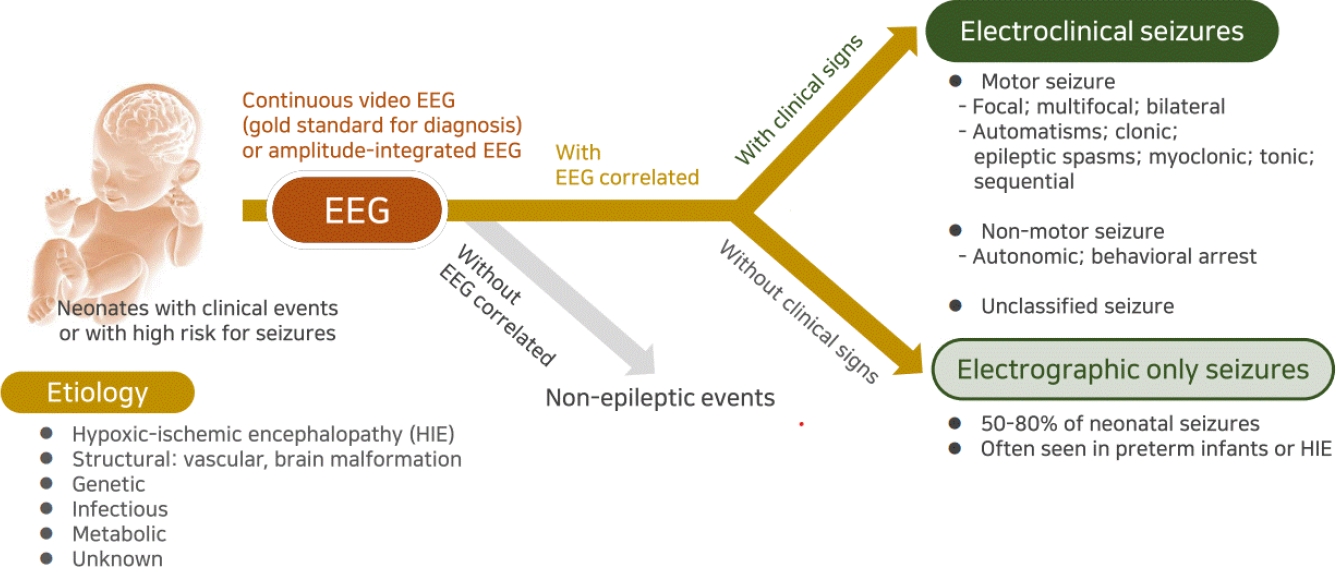
· Neonatal seizures are often electrographic-only seizures without clinical signs; therefore, the identification of electrical seizure activity on electroencephalography is the gold standard for diagnosis.
· Clinical signs of neonatal seizures are divided into motor or nonmotor seizures, and motor seizures are mostly focal or multifocal.
· Most neonatal seizures are caused by acute symptomatic etiologies, but in cases of intractable seizures, structural, genetic, or metabolic etiologies should be investigated.
- Infection
- Therapeutics for the treatment of coronavirus disease 2019 in children and adolescents
- Soo-Han Choi, Jae Hong Choi, Ki Wook Yun
- Clin Exp Pediatr. 2022;65(8):377-386. Published online June 27, 2022
-
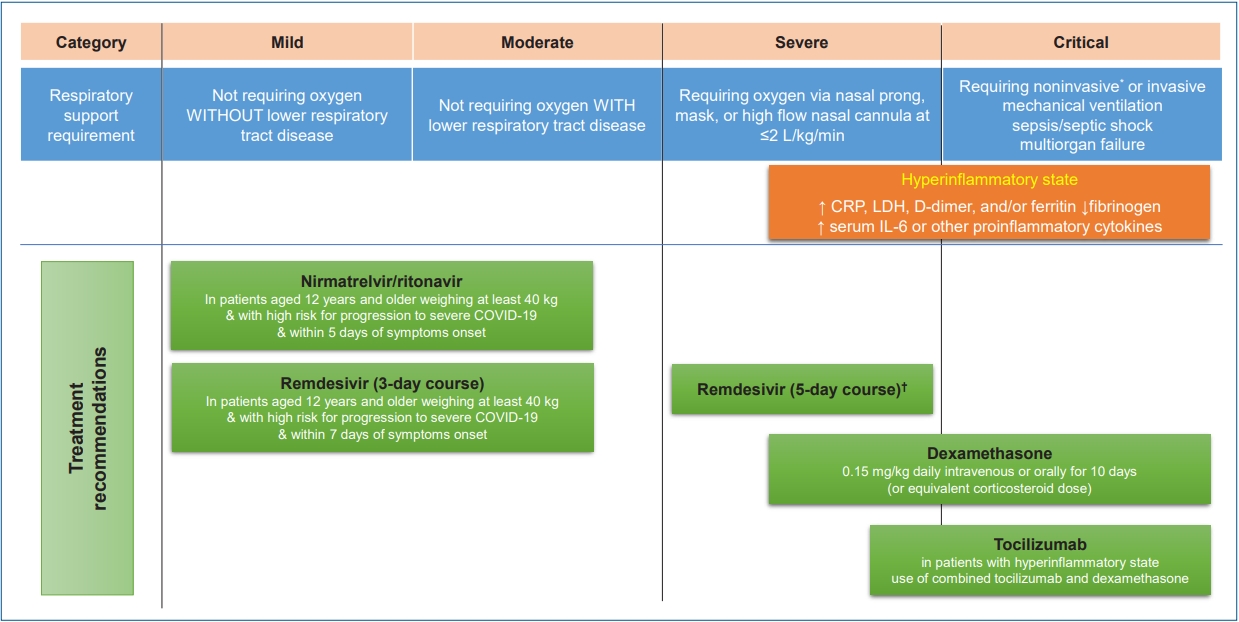
· Children and adolescents with high risks for severe coronavirus disease 2019 (COVID-19) should be identified and proper treatment should be provided promptly according to the patient’s condition.
· Remdesivir can be considered for pediatric patients of all ages with COVID-19 who have an emergent or increase in supplemental oxygen.
· The use of corticosteroids is not recommended for patients with nonsevere COVID-19. Corticosteroids are recommended in children and adolescents with severe and critical COVID-19.
- Nephrology (Genitourinary)
- Neonatal hypertension: concerns within and beyond the neonatal intensive care unit
- Kathleen Altemose, Janis M. Dionne
- Clin Exp Pediatr. 2022;65(8):367-376. Published online May 30, 2022
-
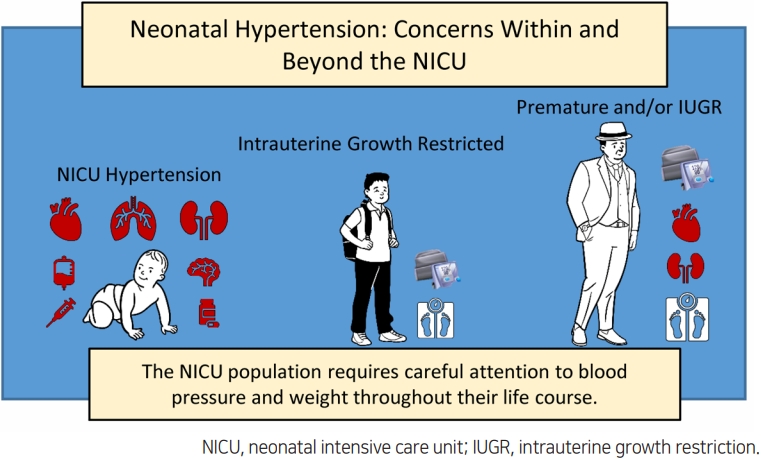
Some neonates, especially those who are premature, may experience hypertension while in the neonatal intensive care unit (NICU). The most common causes are prematurity-related and the hypertension usually resolves over the first 1–2 years of life. Unfortunately, the increasing population of NICU graduates is at risk for later cardiovascular and kidney disease in childhood and adulthood. This population requires careful attention to blood pressure and weight throughout their life course.
- Original Article
- Infection
- Role of lung ultrasound patterns in monitoring coronavirus disease 2019 pneumonia and acute respiratory distress syndrome in children
- Satyabrata Roychowdhoury, Subhajit Bhakta, Manas Kumar Mahapatra, Saptarshi Ghosh, Sayantika Saha, Mithun Chandra Konar, Mihir Sarkar, Mousumi Nandi
- Clin Exp Pediatr. 2022;65(7):358-366. Published online May 13, 2022
-

Question: Potential role of patterns of lung ultrasonography (US) in monitoring changes in mechanically ventilated patients with coronavirus disease 2019 (COVID-19) pneumonia.
Finding: Interstitial syndrome, an irregular pleural line, and peripheral microconsolidation were the most prevalent findings. Changes in lung aeration after mechanical ventilation corelated with improved oxygenation. A fall in lung ultrasound reaeration score ≤ 5 may predict successful weaning.
Meaning: Lung US is gaining wider utility for monitoring COVID-19 pneumonia.
- Neonatology (Perinatology)
- Neonatal sepsis-causing bacterial pathogens and outcome of trends of their antimicrobial susceptibility a 20-year period at a neonatal intensive care unit
- Woo Sun Song, Hye Won Park, Moon Youn Oh, Jae Young Jo, Chae Young Kim, Jung Ju Lee, Euiseok Jung, Byong Sop Lee, Ki-Soo Kim, Ellen Ai-Rhan Kim
- Clin Exp Pediatr. 2022;65(7):350-357. Published online December 9, 2021
-

Question: What is prevalence of bacterial pathogens causing sepsis and their antimicrobial susceptibility over 20 years?
Finding: Coagulase-negative remains most common causative organism. The most common gram-negative organism was Klebsiella pneumonia. The susceptibility of staphylococcus aureus and K. pneumonia showed increased susceptability to oxacillin, cefotaxime and amikacin, gentamicin, respectively.
Meaning: Answers to the question asked is important in choosing antimicrobials and to monitor emergence of multidrug-resistant organisms.
- Editorial
- Pulmonology
- Influence of coronavirus disease 2019 pandemic on respiratory health in children
- Hyo-Bin Kim
- Clin Exp Pediatr. 2022;65(7):348-349. Published online May 3, 2022
-
· Practicing hand hygiene, wearing a mask, maintaining social distancing, and other lockdown measures were implemented to reduce the spread of coronavirus disease 2019 (COVID-19), a worldwide disaster that started in 2019.
· The advent of the worldwide COVID-19 pandemic resulted in positive secondary effects, such as reduced respiratory viral infections in children and decreased degrees of air pollution.
- Neonatology (Perinatology)
- Ideal timing for aggressive screening to detect developmental dysplasia of the hip in term and preterm infants
- Won-Ho Hahn
- Clin Exp Pediatr. 2022;65(7):346-347. Published online March 14, 2022
-

The risk factors and pathogenesis of developmental dysplasia of the hip (DDH) are unclear. Moreover, no universal screening method can entirely eliminate the risk of DDH. However, its incidence is significant and its early detection is critical for improving patient prognosis. Although the ideal evaluation time and risk factors, especially for premature infants, are unclear, the necessity for DDH screening programs for term and preterm infants is emerging.
- Nutrition
- Human milk oligosaccharides as immunonutrition key in early life
- Jung Ok Shim
- Clin Exp Pediatr. 2022;65(7):344-345. Published online May 3, 2022
-
· Human milk is a major source of immunonutrients for neonates and infants. Human milk oligosaccharides (HMOs) act as prebiotics and promote the growth of commensal bacteria.
· HMOs inhibit microorganism adhesion to the gut mucosa through interactions with the commensal microbiome and improve gut barrier function by increasing short-chain fatty acid mediated by bifidobacteria and immunomodulation.
· Several randomized controlled trials recently reported on HMOs.
- Review Article
- Gastroenterology
- Clinical importance of immunonutrition in infants: a review of the recent literature
- Ji Sook Park
- Clin Exp Pediatr. 2022;65(7):337-343. Published online February 17, 2022
-

Nutrients are important in the developing immune system. Human milk supplies diverse bioactives to prevent acute infection or chronic inflammation. Immunoglobulins, lactoferrin, and glutamine in human milk decrease gastrointestinal and respiratory infection. Human milk oligosaccharides promote the growth of intestinal microbiota, the gut barrier, and antimicrobial or antiviral activity. Micronutrients act as anti-inflammatory immunonutrients, too. However, the toxicity of some nutrients from an overdose should be considered.
- Other
- Epidemiology of pediatric fractures before versus during the coronavirus disease 2019 pandemic
- Chi Hoon Oh, Siyeong Yoon, Kyung Rae Ko, Young Woo Kwon, Kyeong Mi Kim, Hyun Seo Park, Hogyeong Kang, Inseok Jang, Soonchul Lee
- Clin Exp Pediatr. 2022;65(7):330-336. Published online June 3, 2022
-

∙ The novel coronavirus disease 2019 (COVID-19) was first reported in December 2019 as a cluster outbreak in Wuhan, since then, national lockdowns have included school closures, stay-at-home orders.
∙ The characteristics of adolescent fractures were often related to physical activity such as sports-related injury.
∙ During the COVID-19 pandemic, both in the East and the West, the incidence of fractures in children and adolescents is showing a decreasing trend worldwide.
∙ Fractures in children and adolescents were significantly reduced in the proportion of relatively low-energy damage, and the incidence of fractures in adolescents with greater activity compared to children was reduced.
∙ If COVID-19 pandemic ends, normal academic and sports activities increase due to the easing of lockdown policies, the number of trauma patients related to increased activity may increase rapidly, and clinics should prepare for this change.
- Neurobehavior
- Jeopardized mental health of children and adolescents in coronavirus disease 2019 pandemic
- Bohyun Jin, Sohee Lee, Un Sun Chung
- Clin Exp Pediatr. 2022;65(7):322-329. Published online June 3, 2022
-
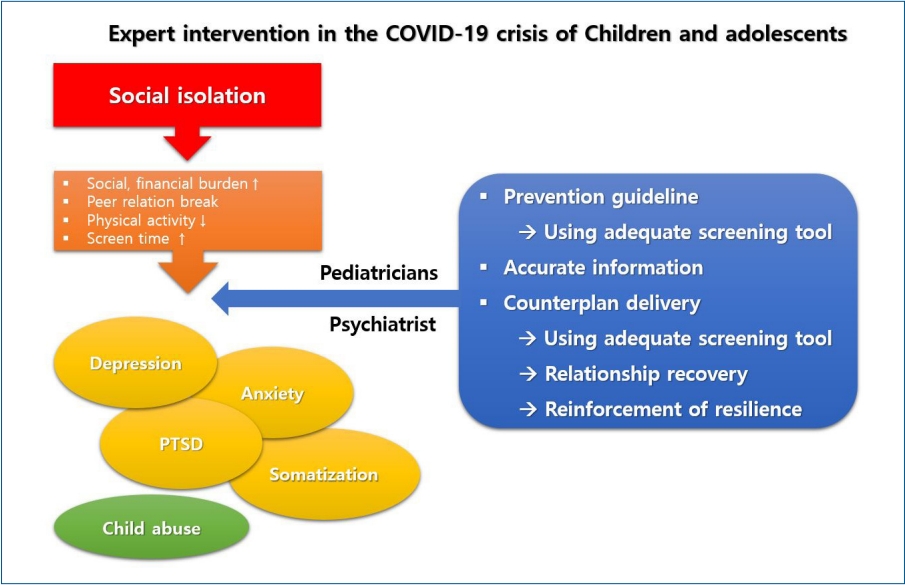
∙ The coronavirus disease 2019 (COVID-19) pandemic has required preventive measures like self-quarantine, school closures, and lockdown, which ultimately make youth directly and indirectly vulnerable to depression, anxiety, posttraumatic stress disorder, and somatization.
∙ Child abuse is more common in the COVID-19 era than previously.
∙ Pediatricians should carefully examine parental and child mental health to directly and indirectly aid their physical and mental health.
- Letter to the Editor
- Infection
- Changes in epidemiology of parainfluenza virus and respiratory syncytial virus infection during coronavirus disease 2019 pandemic in Korea
- Kyung-Ran Kim, Hwanhee Park, Doo Ri Kim, Yae-Jean Kim
- Clin Exp Pediatr. 2022;65(6):320-321. Published online March 10, 2022
-
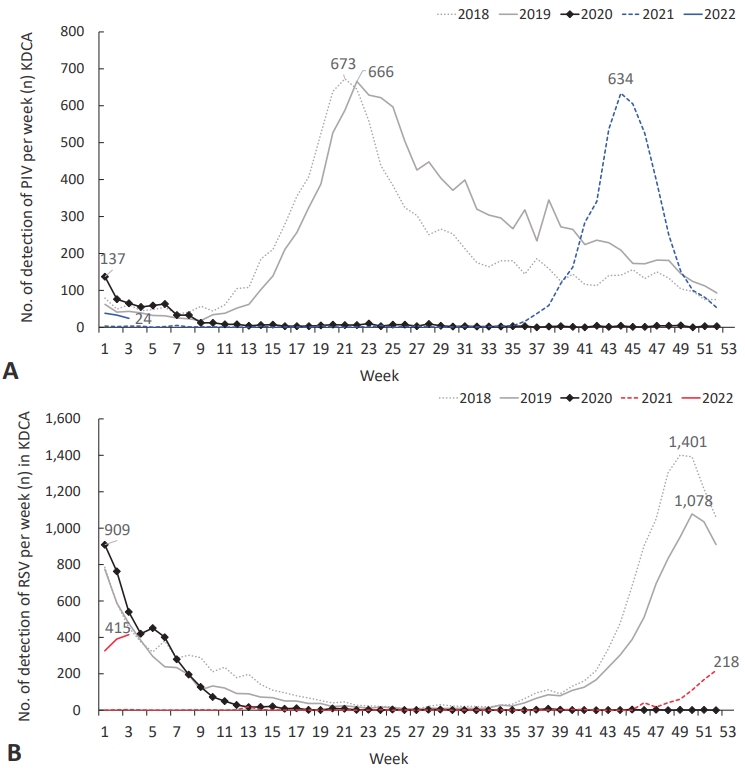
Question: How the epidemiology of other childhood respiratory viruses has changed during coronavirus disease 2019 (COVID-19) in Korea?
Finding: Parainfluenza virus (PIV) typically circulated in the spring, and respiratory syncytial virus (RSV) epidemic started in autumn in Korea before COVID-19 pandemic. PIV and RSV seasons disappeared in 2020 and came back in 2021 with atypical seasonality. PIV season was changed from spring to autumn, and the beginning of RSV season was slightly delayed from autumn to early winter in 2021.
Meaning: Circulation of PIV and RSV was changed to unusual seasons and patterns during COVID-19 pandemic period.
- Original Article
- Neurology
- Neurodevelopmental outcomes and comorbidities of children with congenital muscular torticollis: evaluation using the National Health Screening Program for Infants and Children database
- Og Hyang Kim, Seung Won Lee, Eun Kyo Ha, Ju Hee Kim, Yun Hye Jo, Seongyeong Rhie, Man Yong Han, Kyu Young Chae
- Clin Exp Pediatr. 2022;65(6):312-319. Published online December 9, 2021
-

Question: What comorbidities are increased in children with congenital muscular torticollis (CMT)? Are there differences in the neurodevelopmental outcomes of children with CMT who received physical therapy versus those who did not?
Finding: The risk of congenital musculoskeletal deformities is increased in CMT. Children who did not receive physical therapy were at greater risk of neurodevelopmental delay.
Meaning: In CMT, musculoskeletal comorbidities should be identified and active early treatment provided.
- Endocrinology
- Effects of probiotics combined with dietary and lifestyle modification on clinical, biochemical, and radiological parameters in obese children with nonalcoholic fatty liver disease/nonalcoholic steatohepatitis: a randomized clinical trial
- Thushara Rodrigo, Samaranayake Dulani, Sumudu Nimali Seneviratne, Arjuna P. De Silva, Jerad Fernando, H. Janaka De Silva, Jayasekera , V. Pujitha Wickramasinghe
- Clin Exp Pediatr. 2022;65(6):304-311. Published online November 11, 2021
-
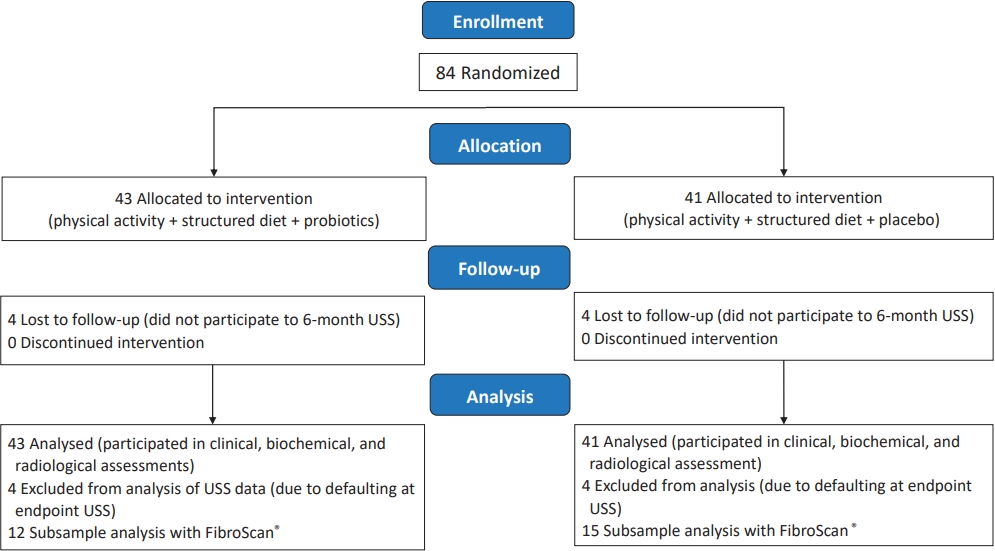
Question: Could probiotics be used as a therapeutic modality in nonalcoholic fatty liver disease/nonalcoholic steatohepatitis?
Finding: There seem no added advantages over lifestyle modifications compared to Probiotics.
Meaning: There does not seem to be an advantage of probiotics over lifestyle modifications in improving obesity-associated metabolic derangement in children.
- Editorial
- Cardiology
- Coronavirus disease 2019 and mRNA vaccines: what’s next – miRNA?
- Joon Kee Lee, Heon-Seok Han
- Clin Exp Pediatr. 2022;65(6):302-303. Published online March 28, 2022
-
MicroRNAs (miRNAs) are small single-stranded noncoding RNA molecules that function in RNA silencing and the posttranscriptional regulation of gene expression. The potential role of miRNAs as biomarkers of myocarditis is promising, and miRNAs are expected to be utilized in various clinical fields in the future.
- Endocrinology
- Low bone mineral density can occur in children after shortterm systemic glucocorticoid treatment
- Moon Bae Ahn
- Clin Exp Pediatr. 2022;65(6):300-301. Published online April 27, 2022
-

Osteoporosis diagnosed in children with chronic diseases is a major endocrine complication triggered by the disease itself or its treatment. Although age upon starting osteotoxic agents and the their duration of use are vital contributors, spontaneous recovery of bone mass following treatment completion is a privilege of this specific age group. For any patients short-term glucocorticoid therapy, bone health screening is the next step.
- Review Article
- Neurology
- Recent trends of healthcare information and communication technologies in pediatrics: a systematic review
- Se young Jung, Keehyuck Lee, Hee Hwang
- Clin Exp Pediatr. 2022;65(6):291-299. Published online December 15, 2021
-

· The innovation of healthcare information communication technology (ICT) was accelerated with the adoption of electronic health records (EHRs).
· Telemedicine currently has no technical barriers.
· EHRs and personal health records are being connected, and mobile/wearable technologies are being integrated into them.
· Conventional rule-based clinical decision support systems have already been implemented and used in EHRs and PHRs. Artificial intelligence/machine learning improves precision and accuracy.
- Endocrinology
- Pediatric hypertension based on Japanese Society of Hypertension Guidelines (JSH 2019) with actual school blood pressure screening data in Japan
- Toru Kikuchi
- Clin Exp Pediatr. 2022;65(6):283-290. Published online November 26, 2021
-

The prevalence of Japanese pediatric hypertension is 0.9% based on proper measurement protocols. Hypertensive children tend to be hypertensive adults. Pediatric essential hypertension is characterized by an absence of symptoms, obesity, a family history of hypertension, and a low birth weight. The most common causes of pediatric secondary hypertension are renal parenchymal and renovascular diseases. Important factors controlling pediatric hypertension include healthy lifestyle modifications and pharmacotherapy.
- Neurology
- Big data analysis and artificial intelligence in epilepsy – common data model analysis and machine learning-based seizure detection and forecasting
- Yoon Gi Chung, Yonghoon Jeon, Sooyoung Yoo, Hunmin Kim, Hee Hwang
- Clin Exp Pediatr. 2022;65(6):272-282. Published online November 26, 2021
-
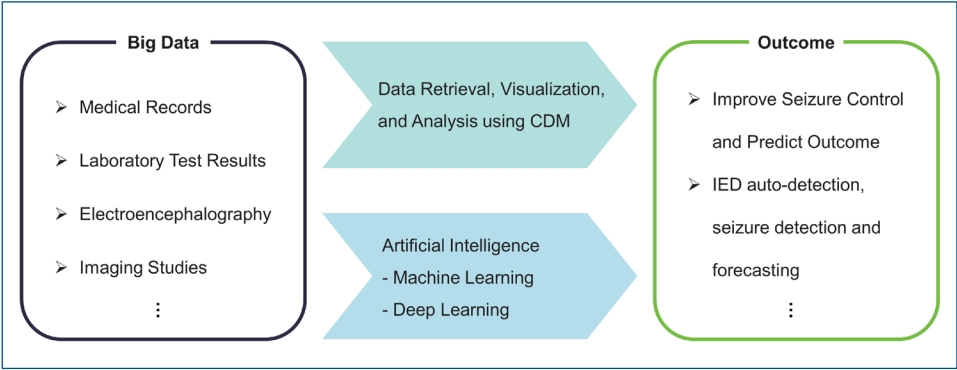
· Big data analysis, such as common data model and artificial intelligence, can solve relevant questions and improve clinical care.
· Recent deep learning studies achieved 0.887–0.996 areas under the receiver operating characteristic curve for automated interictal epileptiform discharge detection.
· Recent deep learning studies achieved 62.3%–99.0% accuracy for interictal-ictal classification in seizure detection and 75.0%– 87.8% sensitivity with a 0.06–0.21/hr false positive rate in seizure forecasting.
- Letter to the Editor
- Neonatology (Perinatology)
- Telemedicine as progressive treatment approach for neonatal jaundice due to the coronavirus disease 2019 pandemic
- Sukanya Sudhir Joshi, Bithiah Roy Benroy, Isabell Nelson Lawrence, Thanuja Jayasri Suresh
- Clin Exp Pediatr. 2022;65(5):269-271. Published online February 7, 2022
-
Question: How can the management of neonatal jaundice (NJ) be enhanced through telemedicine?
Finding: Teleconsultations, drive-through testing, and the use of an application to assess neonatal jaundice at home are being successfully used, but they must be further researched before being implemented on a larger scale.
Meaning: Recent technology allows for the treatment of NJ at home with an application that helps reduce hospital burden.
- Original Article
- Other
- Risk factors and screening timing for developmental dysplasia of the hip in preterm infants
- Ga Won Jeon, Hye Jung Choo, Yong Uk Kwon
- Clin Exp Pediatr. 2022;65(5):262-268. Published online November 5, 2021
-

Question: When is the best screening timing and what is the risk factor for developmental dysplasia of the hip (DDH) in preterm infants?
Finding: Ultrasonography performed earlier than 38 weeks of postmenstrual age caused unnecessary subsequent ultrasonography. DDH did not occur predominantly on the left side or in breech infants.
Meaning: The screening timing, etiology, and risk factors for DDH in preterm infants are somewhat different from those in term infants.
- General Pediatrics
- Effect of 2–6 weeks of systemic steroids on bone mineral density in children
- Athira Kuniyil, Somdipa Pal, Namrita Sachdev, Tribhuvan Pal Yadav
- Clin Exp Pediatr. 2022;65(5):254-261. Published online November 18, 2021
-
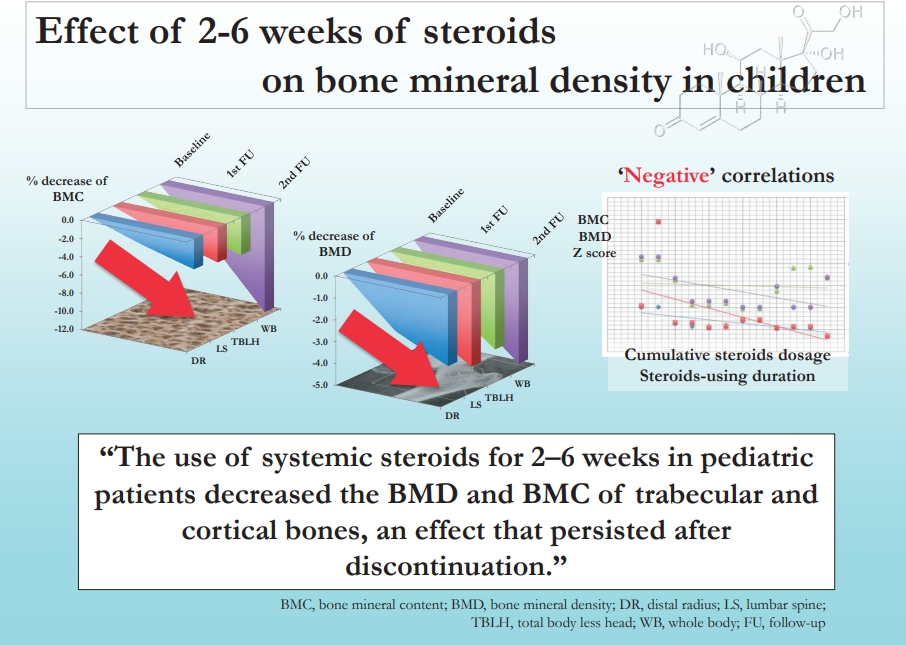
Question: Does steroid use for 2–6 weeks in children affect bone mineral content (BMC) or density (BMD)?
Finding: Steroid use for 2–6 weeks significantly decreased BMC and BMD of the whole body, total body less the head, lumbar spine, and distal radius. A significant negative correlation was observed among BMD, duration, and cumulative dose.
Meaning: Steroid use for 2–6 weeks in children negatively affected BMC and BMD.
- Editorial
- Endocrinology
- Is type 1 diabetes related to coronavirus disease 2019 in children?
- Minsun Kim
- Clin Exp Pediatr. 2022;65(5):252-253. Published online March 29, 2022
-
· Evidence shows that patients with type 1 diabetes have been severely affected by coronavirus disease 2019 (COVID-19) in various ways.
· Although there is no reliable evidence that COVID-19 worsens or induces diabetes, it can impair β-cell insulin secretion and glucose control by inducing inflammation and cytokine production.
· A study is needed of the short- and long-term relationship between diabetes and COVID-19 in the Korean pediatric population.
- Infection
- Effects of nonpharmaceutical interventions for coronavirus disease 2019
- Jae Hong Choi
- Clin Exp Pediatr. 2022;65(5):250-251. Published online March 22, 2022
-
∙ Nonpharmaceutical interventions (NPIs) have decreased the incidence of various infectious diseases, including coronavirus disease 2019 (COVID-19).
∙ During the 2-year COVID-19 pandemic, NPIs changed patients’ daily lives, and the impact on mental health was notable.
∙ The effects of NPIs were evaluated in detail, considering both infections and mental health.
- Review Article
- Other
- Knowledge-guided artificial intelligence technologies for decoding complex multiomics interactions in cells
- Dohoon Lee, Sun Kim
- Clin Exp Pediatr. 2022;65(5):239-249. Published online November 26, 2021
-
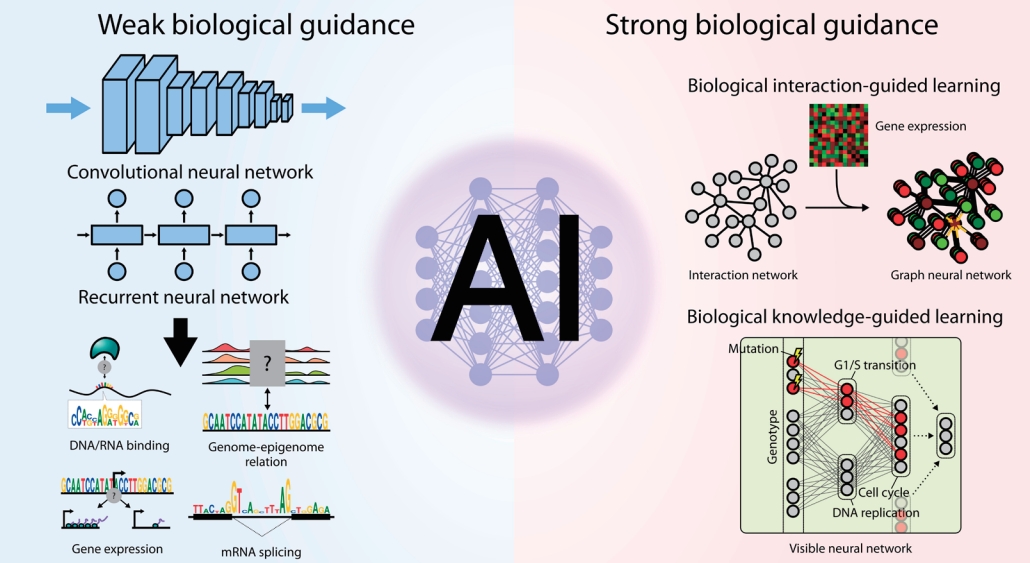
· The need for data-driven modeling of multiomics interactions was recently highlighted.
· Many artificial intelligence-driven models have been developed, but only a few have incorporated biological domain knowledge within model architectures or training procedures.
· Here we provide a comprehensive review of deep learning models to decipher complex multiomics interactions regarding the biological guidance imposed upon them to facilitate further development of biological knowledge-guided deep learning models.
- Cardiology
- Implication of microRNA as a potential biomarker of myocarditis
- Jin-Hee Oh, Gi Beom Kim, Heeyoung Seok
- Clin Exp Pediatr. 2022;65(5):230-238. Published online March 2, 2022
-
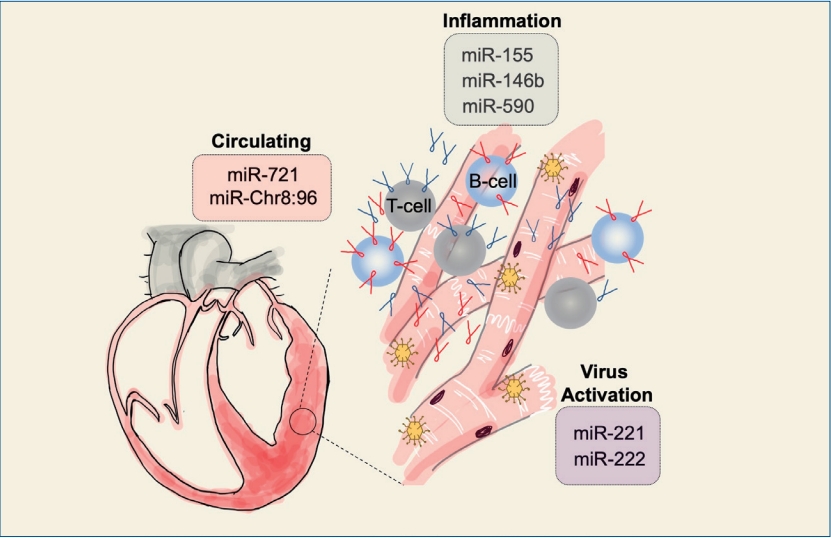
· Myocarditis was recently examined quantitatively as inflammation of the heart muscle based on endomyocardial biopsy, and its noninvasive diagnosis remains unsatisfactory.
· Additionally, numerous miRNAs (miR-155, miR-146b, miR-590, miR-221, miR-222, etc.) coupled with inflammation or viral activation have been examined in myocarditis patients or mouse models.
· The recent identification of mmu-miR-721 (has-miR-Chr8: 96), a myocarditis-specific microRNA, demonstrated its potential as an acute myocarditis biomarker.
- Neurobehavior
- Psychological aspects in children and parents of children with chronic kidney disease and their families
- Alemsungla Aier, Priya Pais, Vijaya Raman
- Clin Exp Pediatr. 2022;65(5):222-229. Published online November 10, 2021
-
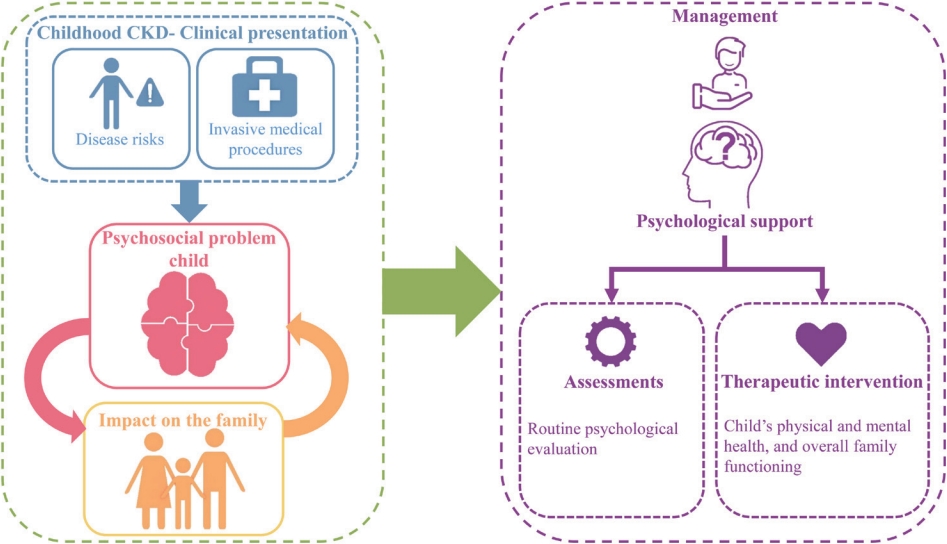
· Childhood chronic kidney disease (CKD) is complex and requires lifetime medical treatment.
· Children with CKD are at risk for emotional, behavioral, social, and academic difficulties that significantly affect their quality of life.
· Caring for children with CKD is stressful for families.
· These unique challenges are crucial and can negatively impact treatment outcomes.
· Awareness of and addressing these evolving psychosocial issues can foster their developing needs.
- Infection
- Four months of rifampicin monotherapy for latent tuberculosis infection in children
- Chi Eun Oh, Dick Menzies
- Clin Exp Pediatr. 2022;65(5):214-221. Published online October 29, 2021
-
· Recently, the importance of a short-term treatment regimen including rifamycin has been highlighted in the treatment of latent tuberculosis infection (LTBI).
· Four prospective or retrospective studies in children consistently reported that a 4-month daily rifampicin regimen (4R) had a higher completion rate than and comparable safety to a nine-month daily isoniazid regimen.
· We suggest rifampicin 20–30 mg/kg/day for children aged 0–2 years and 15–20 mg/kg/day for children aged 2–10 years in 4R to treat LTBI.
-

-
-

-

-
Impact Factor4.2
-
6.52022CiteScore92nd percentilePowered by







